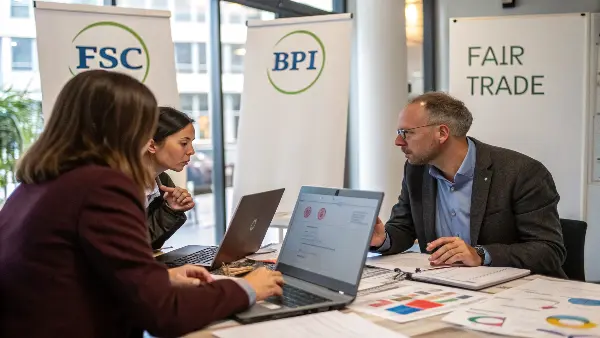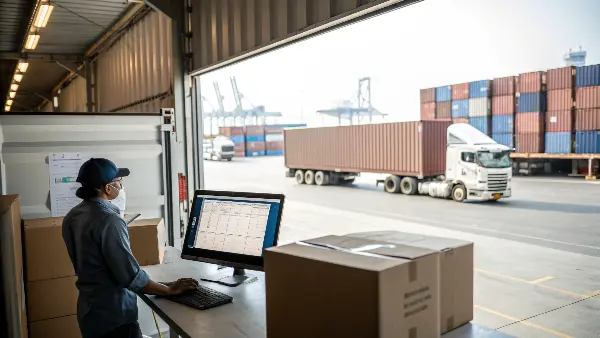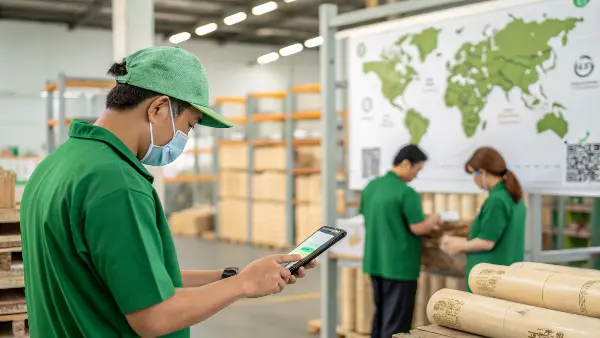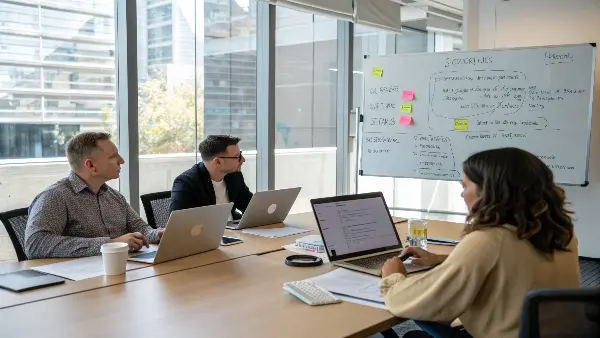Are you struggling to align your supply chain with your company’s green mission? It’s a huge challenge when hidden environmental costs and unreliable partners threaten to undermine your brand’s credibility. What if you could build a supply chain that is not just eco-friendly, but also transparent, efficient, and resilient against disruptions?
To build a sustainable supply chain, you must focus on four key areas. First, rigorously vet suppliers for certifications and ethical practices. Second, optimize logistics to minimize your carbon footprint. Third, implement transparent traceability systems to track products from origin to shelf. Finally, you need to continuously collaborate with partners like us to innovate and improve sustainability metrics. This holistic approach ensures resilience and maintains your brand’s integrity.

Over the years, I’ve seen many companies with great intentions stumble when it comes to their supply chain. It’s the invisible backbone of your business, and if it’s not strong and sustainable, your entire brand is at risk. But don’t worry, creating a truly green supply chain is achievable.
Let’s dive into the practical steps that will help you build a supply chain you can be proud of.
How Do You Choose the Right Sustainable Suppliers?
Finding a genuinely sustainable supplier can feel like searching for a needle in a haystack. Many suppliers claim to be "green," but their practices don’t always match their marketing. Choosing the wrong partner can lead to compliance failures or accusations of greenwashing, damaging the trust you’ve built with your customers. A systematic vetting process is your best defense.
To choose the right sustainable suppliers, start by verifying key certifications like FSC for paper, BPI for compostability, and Fair Trade for ethics. Next, assess their manufacturing processes and labor standards through third-party audits. Finally, request material traceability documents and test samples to confirm quality and compliance. A partner who is transparent and communicative about their process is always a reliable choice.

Choosing a supplier is more than just a transaction; it’s a partnership. A great partner will not only meet your standards but will also work with you to find new ways to improve. At Ecosourcecn, we’ve built our reputation on this kind of transparency. We believe you should know exactly where your products come from and how they are made.
Creating Your Supplier Vetting Checklist
A structured approach is essential. Don’t just rely on a supplier’s website. You need to dig deeper to verify their claims. I recommend creating a scorecard or a checklist to evaluate potential partners consistently. This process should cover three critical areas: certifications, operational transparency, and product quality.
First, let’s talk about certifications. These are non-negotiable. They are third-party validations of a supplier’s claims. For Jacky, our packaging specialist in Canada, knowing a product meets EN13432 or ASTM D6400 standards is crucial for market access.
Here’s a table of common certifications and what they mean:
| Certification | What It Verifies | Why It’s Important |
|---|---|---|
| BPI / B-Corp | A product is compostable / A business meets high social & environmental standards. | Ensures product end-of-life claims are valid and the business operates ethically. |
| FSC | Paper and wood products come from responsibly managed forests. | Prevents deforestation and protects ecosystems. |
| EN13432/ASTM D6400 | Compliance with industrial composting standards. | Guarantees your product will break down as advertised in commercial facilities. |
| LFGB / FDA | Food-safe materials for packaging and tableware. | Protects consumer health and ensures regulatory compliance. |
Beyond the Paperwork
Next, look at their operational transparency. Ask for a virtual tour of their facility. Inquire about their waste management, water usage, and energy sources. A truly sustainable supplier will be proud to share this information. Finally, always get product samples. Test them for durability, quality, and performance to ensure they meet your brand’s standards before placing a large order. This rigorous process protects your brand and builds a foundation of trust.
How Can You Minimize the Carbon Footprint of Your Logistics?
You’ve sourced the perfect eco-friendly product, but now you have to ship it across the globe. The environmental impact of transportation can erase all the sustainability gains you made in production. This logistics puzzle can feel overwhelming, leaving you wondering if a global supply chain can ever be truly green. It absolutely can, with strategic planning.
To minimize your logistics carbon footprint, consolidate shipments to maximize container space and reduce the number of trips. Prioritize ocean freight over air freight, as it is significantly less carbon-intensive. Also, work with logistics partners who offer carbon offsetting programs and use route optimization software. Sourcing from a partner who can manage and bundle products from different factories helps streamline this process.

Reducing your carbon footprint in logistics isn’t just about being good to the planet; it’s also good for business. Efficient shipping means lower costs and less risk of delays. I’ve worked with clients like Jacky to design shipping plans that not only reduce emissions but also save them money. The key is to think smart and plan ahead.
Strategic Shipping and Route Optimization
The first and most impactful step is to choose your mode of transport wisely. Air freight is fast, but it’s an environmental disaster compared to ocean freight. For most inventory planning, sea travel is the way to go. The CO2 emissions per ton-kilometer for ocean freight can be up to 50 times lower than for air freight.
The next step is to ship smarter, not more often. We advise our clients to consolidate orders. Instead of shipping multiple small orders, plan your inventory needs to fill a full container load (FCL). This is far more efficient than multiple less-than-container load (LCL) shipments. At Ecosourcecn, we often act as a hub, collecting products from various specialized factories to fill a single container for a client. This service alone cuts down on transportation legs and simplifies customs clearance.
The Role of Technology and Partnerships
Modern logistics partners use sophisticated software to optimize shipping routes. These programs account for weather, port congestion, and fuel consumption to find the most efficient path. Ask your freight forwarder if they use these tools. Furthermore, consider partners who offer carbon offsetting. For a small additional cost, these programs invest in environmental projects, like reforestation, to neutralize the carbon emissions from your shipment.
Here’s a quick comparison to illustrate the impact:
| Shipping Factor | Low-Impact Approach | High-Impact Approach |
|---|---|---|
| Mode of Transport | Ocean Freight | Air Freight |
| Shipment Size | Full Container Load (FCL) | Less-than-Container Load (LCL) |
| Planning | Route optimization software | Direct, non-optimized routes |
| Carbon Neutrality | Participating in carbon offset programs | Ignoring shipment emissions |
By focusing on these areas, you can significantly reduce the environmental cost of getting your products to market.
What Does True Transparency and Traceability Look Like?
You claim your products are made from sustainably sourced bamboo, but can you prove it? In today’s market, consumers and B2B buyers like Jacky demand to know the story behind their products. A lack of transparency can create doubt and suspicion, while a single supply chain issue you can’t explain can ruin your reputation.
True transparency means mapping your entire supply chain, from the raw material source to the final product. It involves using tools like batch codes or QR codes to track each component. This allows you to provide customers with verifiable proof of your product’s origin, certifications, and journey. A transparent system builds trust and allows for quick action if an issue arises.

Traceability is not just about marketing; it’s about accountability and risk management. I remember a time when a client faced a question about the specific forest their paper products came from. Because we had a robust traceability system in place, we were able to provide the FSC chain of custody documents within hours, satisfying their customer and reinforcing trust.
Building a Traceable Supply Chain
The first step is supplier collaboration. You need partners who are willing and able to provide detailed documentation for every batch of materials. This starts with the raw material. For our bagasse products, for example, we document which sugar cane processing facility the raw fiber came from. For our PLA products, we trace the corn or sugarcane back to its origin.
This information is then linked to production batches. Each production run gets a unique batch code. This code stays with the product through its entire journey. We use this system to track everything.
Here’s a breakdown of how it works:
- Raw Material Documentation: We collect certificates of origin and sustainability for all raw materials. For instance, our FSC-certified paper suppliers provide a chain of custody number.
- Batch Code Assignment: During manufacturing, each batch of products is assigned a unique code that links back to the raw material documents.
- Digital Record-Keeping: All this information is stored in a central database. We can pull up a product’s entire history using its batch code.
- Customer-Facing Information: We can share this information with our clients. Some brands choose to put a QR code on their packaging. When a consumer scans it, they can see the product’s journey, from the forest to their hands.
The Benefits of Radical Transparency
This level of detail might seem excessive, but it has huge benefits. First, it builds incredible trust. When you can back up every claim with data, customers know you’re serious about sustainability. Second, it’s a powerful risk management tool. If a quality issue ever arises, you can instantly isolate the affected batch, identify the root cause, and prevent it from happening again. This protects your customers and your brand. True transparency is about being able to stand behind your product with complete confidence.
How Do You Balance Cost with Sustainability Goals?
Let’s be honest: pursuing sustainability can feel expensive. Eco-friendly materials, certified suppliers, and ethical practices often come with a higher price tag than conventional options. This can create a conflict between your budget and your values, forcing you to wonder if you can afford to be as green as you want to be.
Balancing cost and sustainability requires a total cost of ownership mindset, not just a purchase price comparison. Factor in long-term benefits like brand loyalty, market access, and reduced risk. You can also lower costs by optimizing your supply chain through bulk purchasing, efficient logistics, and partnering with suppliers who can help you design products that use materials more effectively.

I’ve had countless conversations with buyers who are worried about the cost of switching to sustainable products. My advice is always the same: don’t look at the line-item cost, look at the overall value. A slightly more expensive, certified compostable container might open up new markets or win you a contract with a major eco-conscious retailer. That’s a return on investment that goes far beyond the initial price.
Rethinking the Definition of "Cost"
The price tag on an invoice is only one part of the total cost. A cheap, non-sustainable product carries hidden risks and missed opportunities. Think about it from a total value perspective.
Here’s a practical comparison:
| Metric | Conventional Product | Sustainable Product |
|---|---|---|
| Unit Price | Lower | Higher |
| Brand Image | No benefit, potential for negative perception. | Enhanced reputation, attracts eco-conscious consumers. |
| Market Access | May be restricted by regulations (e.g., plastic bans). | Unlocks access to green markets and retailers. |
| Risk | High risk of regulatory fines or greenwashing claims. | Lower risk, meets compliance standards. |
| Customer Loyalty | Price-driven, low loyalty. | Value-driven, builds strong customer loyalty. |
Practical Strategies for Cost Management
Even with a value-based mindset, you still need to manage your budget. One of the most effective strategies is smart product design. Sometimes a small change in a container’s design can reduce the amount of material needed without sacrificing performance. We often work with clients like Jacky to co-design packaging that is both sustainable and cost-effective.
Another key is volume and planning. By forecasting your needs and placing larger, less frequent orders, you can get better pricing and save a lot on shipping. This goes back to consolidating shipments. Finally, work with a partner like Ecosourcecn who has a wide network. We can source high-quality materials and leverage our relationships with factories to get you the best possible price without compromising your sustainability standards. Being green doesn’t have to break the bank.
Conclusion
Building a truly sustainable supply chain is a journey, not a destination. It requires careful supplier selection, smart logistics, radical transparency, and a balanced approach to cost. By focusing on these key areas, you can create a resilient and responsible supply chain that strengthens your brand and contributes to a healthier planet.


